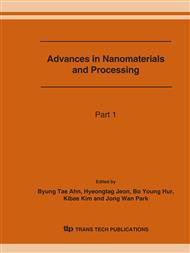p.1493
p.1497
p.1501
p.1505
p.1509
p.1513
p.1517
p.1521
p.1525
Properties of Preferred Orientation of TiO2 Thin Film on Plasma Pretreated Substrate
Abstract:
The degree of preference of thin anatase TiO2 films prepared by CVD for the <112> orientation was enhanced by pretreating the soda-lime glass substrates with a plasma. The relationships between the preferred orientation and plasma pretreatments were investigated. It was founded that the TiO2 films on the plasma pretreated soda-lime glass substrates exhibited a higher degree of preference for the (112) orientation than those without the pretreatment. To confirm the effect of the plasma pretreatments on the soda-lime glass substrates, TOF-SIMS, contact angle measurement and TEM were used to determine the changes in the components, surface energy and crystallinity of the substrates, respectively. It was found the components added as network modifiers, such as Na+, Ca2+, and K+ ions, was depleted in the surface region of the substrates after the plasma pretreatment, and that the surface energy of the substrates was increased. Finally, it was observed that the substrate surface was changed from an amorphous phase to polycrystalline. To sum up, it was assumed that the surface of the soda-lime glass substrates with their partially crystalline, namely poly-crystalline, structures artificially induced the thin anatase TiO2 films to develop with a <112>-preferred orientation. In conclusion, the plasma pretreatment of the glass substrate caused the TiO2 thin films to exhibit a higher preference for the <112> orientation, thereby optimizing their photocatalytic efficiency.
Info:
Periodical:
Pages:
1509-1512
Citation:
Online since:
June 2007
Authors:
Price:
Сopyright:
© 2007 Trans Tech Publications Ltd. All Rights Reserved
Share:
Citation:


